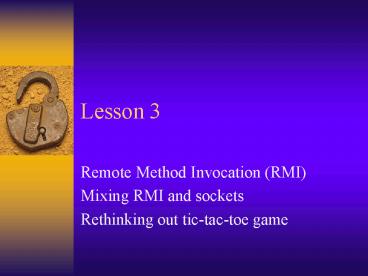Remote Method Invocation RMI - PowerPoint PPT Presentation
1 / 18
Title:
Remote Method Invocation RMI
Description:
Simple idea objects existing on one machine (server) may be ... Call java.rmi.Naming.bind(...) to store the register the object with the naming service ... – PowerPoint PPT presentation
Number of Views:472
Avg rating:3.0/5.0
Title: Remote Method Invocation RMI
1
Lesson 3
- Remote Method Invocation (RMI)
- Mixing RMI and sockets
- Rethinking out tic-tac-toe game
2
Distributed Objects
- Simple idea objects existing on one machine
(server) may be accessed from another machine
through regular method call. - Eliminates need to marshal and unmarshal data
sent over sockets - Underlying socket code still exists, but is not
programmed by user.
3
RMI vs. CORBA
- RMI is Java framework for creating distributed
object applications Remote Method Invocation - CORBA is alternative technology based on open
standard Common Object Request Broker
Architecture - RMI is only for pure Java applications CORBA is
language independent - JNI makes this distinction a little less rigid
since it allows Java to interact with other
languages
4
Socket flow of events -- synchronous
Client
Server
- Get user input
- Decode user input
- Create server message
- Send message to server
- Await server response
- Receive server message
- Decode reply
- Send output to user
- Await client message
- Receive client message
- Decode client message
- Perform action
- Create client message
- Send to client
Method call on standalone object
5
Socket flow - asynchronous
Client1
Server
Client2
- Wait
- Receive client msg
- Decode client msg
- Perform action
- Create client message
- Send to client1
- Send to client2
- User input (UI)
- Decode UI
- Create srvr msg
- Send srvr msg
- Await srvr reply
- Receive server message
- Decode reply
- Output to user
- User input (UI)
- Decode UI
- Create srvr msg
- Send srvr msg
- Await srvr reply
- Receive server message
- Decode reply
- Output to user
6
RMI flow of events -- synchronous
Client
Server
- Instantiate object(s)
- Bind to registry
- Get/cache remote obj ref
- Get user input
- Decode user input
- Remote method call
- Decode return value
- Send output to user
7
RMI Cartoon1
8
RMI Cartoon2
9
Steps for RMI Application
- Implement both client and server on single
machine to test - Create two directories
- client
- server
10
RMI steps, server side
- Three files need to be created
- The implementation class (Foo.java)
- An interface listing the methods in the
implementation class which you want to make
remote (FooInterface.java) - A server class, which creates one or more
implementation objects and posts them to the
registry (FooServer.java)
11
Creating the interface
- Interface file (e.g. StoreInterface.java)
- StoreInterface must extend java.rmi.Remote
- All methods in interface must throw
java.rmi.RemoteException - Implementation file (e.g Store.java)
- Store must extend java.rmi.server.UnicastRemoteObj
ect - Store must implement StoreInterface
- Program implementations. Be sure to throw
RemoteException in remote methods - Explicitly include a null construct that calls
super()
12
Creating Stubs
- The stub or proxy code is generated automatically
by using the rmic utility. - Once the interface and implementation classes are
complete, generate the stubs as follows - rmic v1.2 Store
- This creates Store_Stub.java the java
networking layer that transparently handles the
underlying message passing.
13
Creating the server class
- Server class (e.g. StoreServer.java)
- Create a new object instance
- Call java.rmi.Naming.bind() to store the
register the object with the naming service - contains String name associated with bound
object
14
Steps for RMI, cont.
- Create the client
- Change to the client dir and copy Store.class and
Store_Stub.class (or you can import them but
remember that these will ultimately be on
different machines). - Create StoreClient.java and import
- java.rmi.Naming java.rmi.RemoteException
java.net.MalformedURLException
java.rmi.NotBoundException
15
Steps for rmi, cont.
- Call Naming.lookup() to get remote object
reference (be sure to cast to interface type). - Be sure to handle imported exceptions
- Once you get remote object reference, handle as
regular object (there are some subtle differences
that well explore later).
16
Deploying the Application
- Start the rmiregistry
- rmiregistry (Unix)
- start rmiregistry (Windows)
- Start the StoreServer class
- java StoreServer (Unix)
- Run the client
- Thats it!
17
Additional Issues covered next time
- Objects which are not remote are copied (slow!)
- Stub and interface codes can be downloaded by
client (typical for real distributed systems) - Security issues in real system (see ch. 5 in Core
Java 2) - Subtleties with Object methods (clone, etc)
- Using callbacks with RMI
- Synchronization
- Registering multiple objects
- Bottom Line Dont be too fancy!
18
Examples
- tic-tac-toe reorganized as standalone back-end
object - single-threaded test of TTT object
- multithreaded test of TTT object using polling
- client-server TTT using RMI and polling
- client-server TTT using RMI over sockets
- client-server TTT using RMI callbacks.































